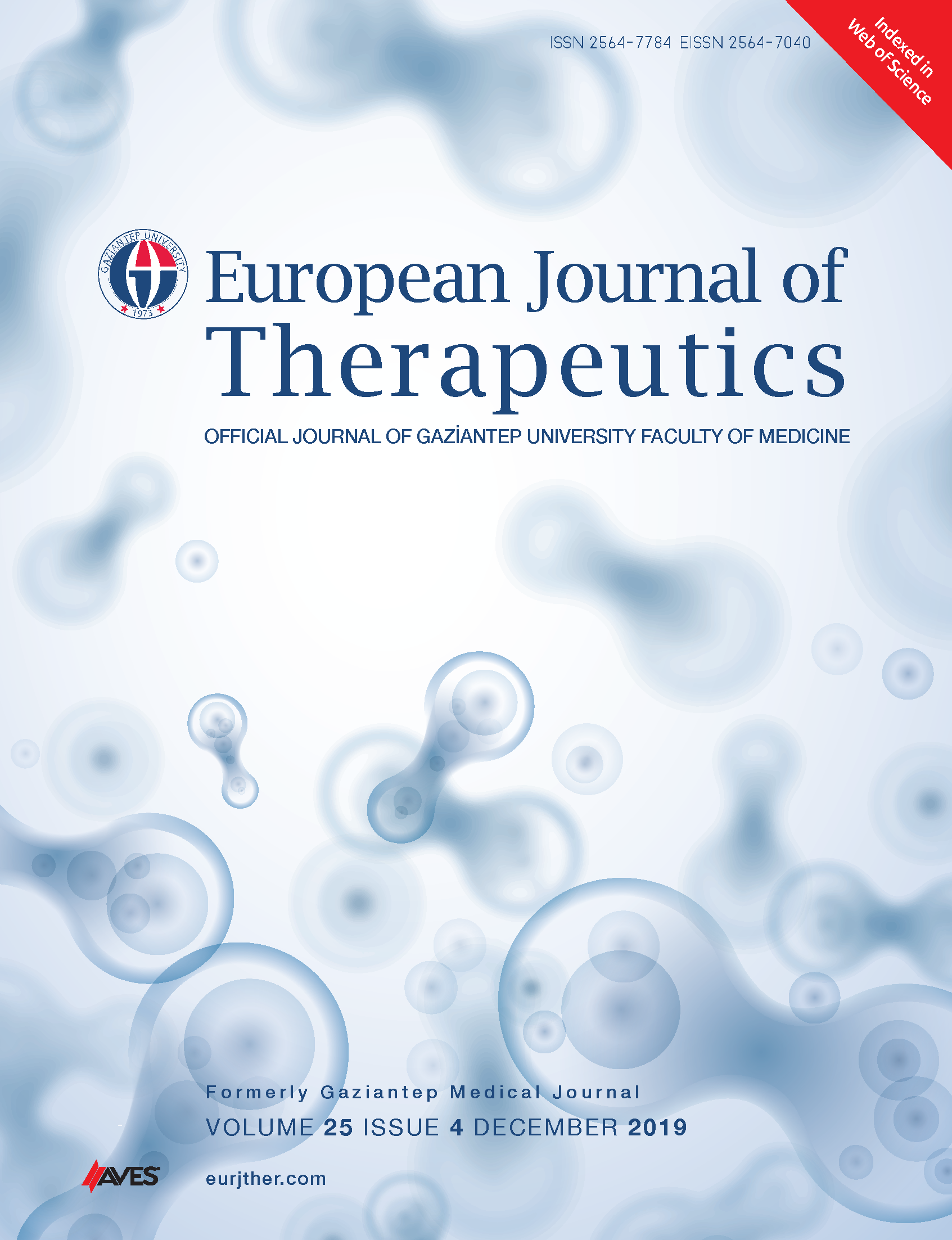Residual Stress Levels on the Cortical Section of Vertebral Bone Tissue
DOI:
https://doi.org/10.5152/EurJTher.2019.18016Keywords:
Deformation, nano-cracks, residual stress, vertebral boneAbstract
Objective: Residual stress can cause deformation and cracks in the bone tissue. The aim of our study is to measure the residual stress level and distribution in the cortical bone of the extremities of vertebrates.
Methods: Residual stress levels in the bone tissue of 12 sheeps aged 2 years were measured by observing the cortical parts of 6 different (C1, C3, Th1, Th 13, L1, and L6) vertebral bones by means of the X-ray diffraction method. This method is recognized as the one that can measure residual stress in the bone tissue most accurately. By means of special methods, the cortical part of vertebral bone was separated from its trabecular part. The bone tissue was left to stand for a long time to dry completely. Measurements were performed on completely dried tissues using an X-ray diffraction apparatus. The residual stress values obtained from all the subject groups were compared statistically.
Results: It was found that the residual stress level was the highest in C3 and that it showed a statistically significant change as compared to the levels in C7, Th1, and Th13. Although the level in C3 was high as compared to the levels in L1 and L6, it was not statistically significant.
Conclusion: The residual stress level in the C3 vertebral cortical section was significantly higher than other parts and was interpreted as such by us, i.e., anatomically, it is one of the vertebrae that keep the head upright and is the vertebra carrying the maximum load in all natural processes.
Metrics
References
Yamada S, Tadano S, Fujisaki K. Residual stress distribution in rabbit limb bones. J Biomech 2001; 44: 1285-90.
Hızal A, Sadasivam B. Residual stress in bone: A parametric study. Proceedings of IMECE 2008. ASME International Mechenical engineering Congress and Exposition. 31-09/06-10-2008; Boston, Massachusetts, USA.
Fung YC. Biomechanics: Motion, Flow, stress and Growth. Springer, Berlin Heidelberg. New York. USA pp. 1990. 388-3, 500-3.
Tadano S, Okoshi T. Residual stress in bone structure and tissue of rabbit’s tibiofibula. Biomed Mater Engin 2006; 16: 11-21.
Rossini NS, Dassisti M, Benyounis KY, Olabi AG. Methods of measuring residual stresses in components. Materials & Design 2012; 35: 572-88.
Yamada S, Tadano S. Residual stress around the cortical sürfece in bovine femoral diaphysis. J Biomech Eng 2010; 132: 31-4.
Fujisaki K, Tadano S, Sasaki N. A method on strain measurement of HAp in cortical bone from diffusive profile of X-ray difraction. J Biomech 2006; 39: 379-86.
Gupta HS, Seto J, Wagermainer W, Zaslansky P, Boesecke P, Fratzl P. Cooperative deformation of mineral and collagen in bone at the nanoscale. Proc Natl Acad Sci U S A 2006; 103: 17741-6.
Almer JD, Stock SR. Micromechanical response of mineral and collagen phases in bone. J Struct Biol 2007; 157: 365-70.
Fujisaki K, Tadano S. Relationship between bone tissue strain and lattice strain of HAp crystals in bovine cortical bone under tensile loading. J Biomech 2007; 40: 1832-8.
Tadano S, Giri B, Sato T, Fujisaki K, Todoh M. Estimating nanoscale deformation in bone X-ray difraction imaging method. J Biomech 2008; 41: 945-52.
Giri B, Tadano S, Fujisaki K, Sasaki N. Deformation of crystal in cortical bone depending on structural anisotropy. Bone 2009; 44: 1111-20.
Currey JD. Bones: Structures and Mechanics. Princeton University Press, USA, 2002; pp.14-21.
Gibson VA, Stover SM, Gibeling JC, Hazelwood SJ, Martin RB. Osteonal effects on elastic modulus and fatigue life in equine bone. J Biomech 2006; 39: 217-25.
Rho JY, Zioupos P, Currey JD, Pharr GM. Variations in the individual thick lamellar properties within osteons by nanoindentation. Bone 1999; 25: 295-300.
Rho JY, Ashman RB, Turner CH. Young’s modulus of trabecular and cortical bone material: ultrasonic and microtensile measurements. J Biomech 1993; 26: 111-9.
Mason MW, Skedros JG, Bloebaum RD. Evidence of strain-mode-related cortical adaptation in the diaphysis of the horse radius. Bone 1995; 17: 229-37.
Skedros JG, Mendenhall SD, Kiser CJ, Winet H. Interpreting cortical bone adaptation and load history by quantifying osteon morphotypes in circularly polarized light images. Bone 2009; 44: 392-403.
Skedros JG, Sorenson SM, Takano Y, Turner CH. Dissociation of mineral and collagen orientations may differentially adapt compact bone for regional loading environments: results from acoustic velocity measurements in deer calcanei. Bone 2006; 39; 143-51.
Adachi T, Tanaka M, Tomita Y. Uniform stress state in bone structure with residual stress. J Biomech Eng 1998; 120: 342-7.
Downloads
Published
How to Cite
Issue
Section
License
Copyright (c) 2023 European Journal of Therapeutics

This work is licensed under a Creative Commons Attribution-NonCommercial 4.0 International License.
The content of this journal is licensed under a Creative Commons Attribution-NonCommercial 4.0 International License.


















